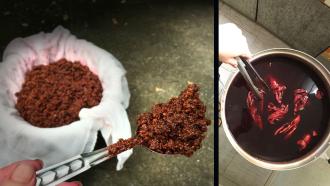Photo: Siddharth Kankaria / Research Matters
Trees hold a special place on the planet. Apart from being an important resource to us, they are also a generous host to many species of fungi and bacteria that spend parts of their life cycle inside the trees. These microorganisms, called endophytes, have a symbiotic relationship with trees, the nature of which depends on the genetic, environmental and geographical conditions. In a recent study, researchers at the Vivekananda Institute of Tropical Mycology (VINSTROM), Chennai, have surveyed about 100 trees from the forests in the Western Ghats to explore a particular endophyte species, Pestalotiopsis, and its interaction with trees within the Nilgiri Biosphere Reserve.
“Endophytes infect plant tissues and reside in them for long or short period of time, without inciting any disease. It is believed that they have played a role in shaping the evolution of plants. Research across the world has shown that the presence of endophytes makes plants more resistant to insect, pest attacks and droughts”, explains Dr. T.S. Suryanarayanan, one of the members of the study team. In their 25 years of study on endophytes, they have never come across a plant that is free of them.
It is estimated that among the 1.5 million species of fungi on earth, only about 7% are now known and there are many undiscovered fungal species that exist as endophytes. During the team’s research spanning two and a half decades, they have observed that dry tropical forests do not support a high diversity of endophytes. “This is due to the fact that some fungi survive as endophytes in taxonomically unrelated plants. They have adaptations to encounter and survive the different defense reactions exhibited by these different plants”, says Dr. Suryanarayanan. This particular study describes some of these adaptations by Pestalotiopsis, a fungal endophyte.
Apart from being non-disease causing endophyte, Pestalotiopsis is found in the leaves of a wide range of host trees and causes leaf spots and affects fruits too. The researchers collected samples from four forest regions within the Western Ghats that are different in terms of altitude and the amount of rainfall they receive. They found that this fungus was present in all the regions, indicating its ability to counter a variety of defense mechanisms exhibited by the trees. “This fungus is known to be producing secondary metabolites that have antibiotic properties. Since we show that a few Pestalotiopsis species have a wide host range and can infect many forest tree species, it would be of interest to screen these for anti-pest properties. If successful, they can be used for pest management”, adds Dr. T.S Suryanarayanan.
Studies have shown that when endophytes are cultured in a laboratory, they produce some novel molecules that have antibiotic, anticancer and antimalarial properties. Earlier, Dr. Suryanarayanan’s team reported that some endophytes, including Pestalotiopsis of the fire-prone forests of the Western Ghats, have spores that are extremely thermo-tolerant and could tolerate exposure to dry heat of 110o C for more than an hour. They even utilize furaldehydes, the most abundant organic volatile compound released by burning plant litter and are toxic to fungi in general. “It is possible that the periodic forest fires have chosen these fungi because of their adaptations. We feel that the ecological niche as endophytes of such thermotolerant fungi would increase with global warming”, adds Dr. Suryanarayanan. With a wide diversity of endophytes where a plant can, at times, have 25 to 30 different species, the possibility of finding properties that can help the forests and us, are endless.






